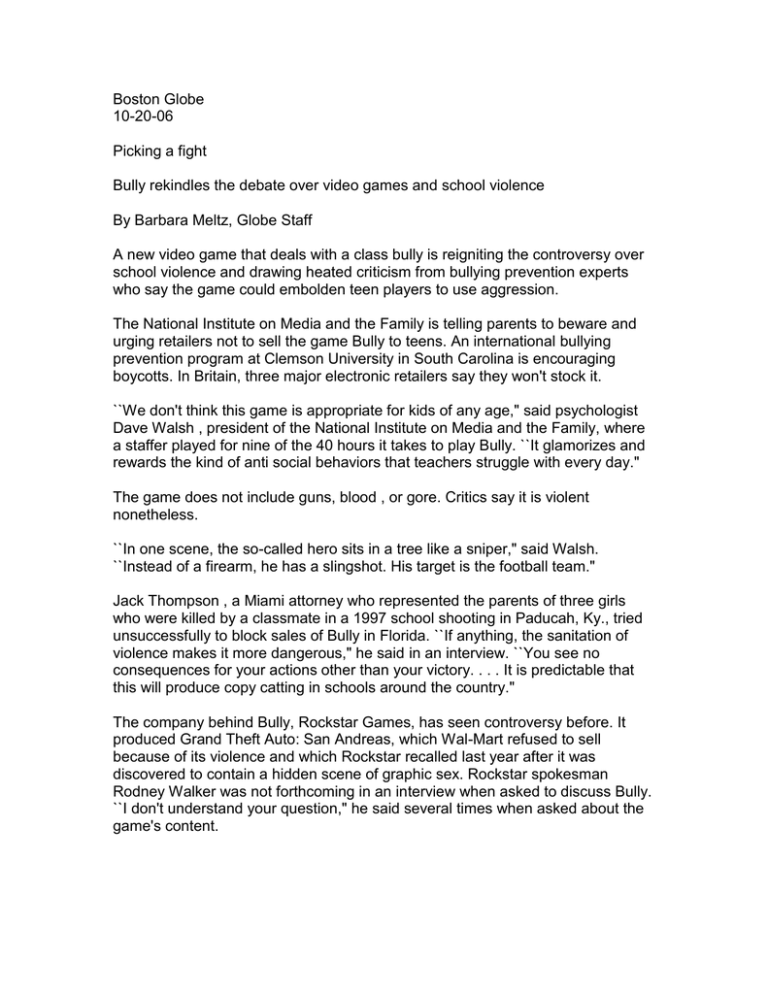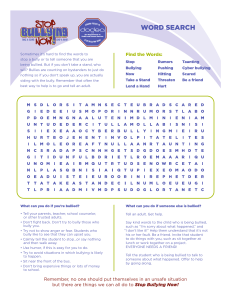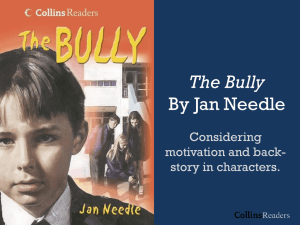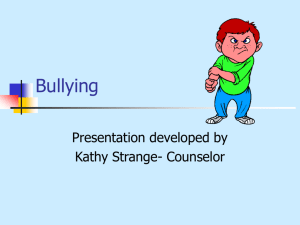Boston Globe 10-20-06 Picking a fight
advertisement

Boston Globe 10-20-06 Picking a fight Bully rekindles the debate over video games and school violence By Barbara Meltz, Globe Staff A new video game that deals with a class bully is reigniting the controversy over school violence and drawing heated criticism from bullying prevention experts who say the game could embolden teen players to use aggression. The National Institute on Media and the Family is telling parents to beware and urging retailers not to sell the game Bully to teens. An international bullying prevention program at Clemson University in South Carolina is encouraging boycotts. In Britain, three major electronic retailers say they won't stock it. ``We don't think this game is appropriate for kids of any age," said psychologist Dave Walsh , president of the National Institute on Media and the Family, where a staffer played for nine of the 40 hours it takes to play Bully. ``It glamorizes and rewards the kind of anti social behaviors that teachers struggle with every day." The game does not include guns, blood , or gore. Critics say it is violent nonetheless. ``In one scene, the so-called hero sits in a tree like a sniper," said Walsh. ``Instead of a firearm, he has a slingshot. His target is the football team." Jack Thompson , a Miami attorney who represented the parents of three girls who were killed by a classmate in a 1997 school shooting in Paducah, Ky., tried unsuccessfully to block sales of Bully in Florida. ``If anything, the sanitation of violence makes it more dangerous," he said in an interview. ``You see no consequences for your actions other than your victory. . . . It is predictable that this will produce copy catting in schools around the country." The company behind Bully, Rockstar Games, has seen controversy before. It produced Grand Theft Auto: San Andreas, which Wal-Mart refused to sell because of its violence and which Rockstar recalled last year after it was discovered to contain a hidden scene of graphic sex. Rockstar spokesman Rodney Walker was not forthcoming in an interview when asked to discuss Bully. ``I don't understand your question," he said several times when asked about the game's content. In a subsequent e-mail, he wrote: ``We'll never convince everyone, but we hope people will enjoy the story in Bully as much as they enjoy similar stories in books, plays, and movies." Bully centers on Jimmy Hopkins , the new kid at a reform school. When he sees nerds being bullied, he decides to help them. ``We encourage bystanders to do that," said Barbara Coloroso , author of ``The Bully, the Bullied , and the Bystander." Unfortunately, she added, ``that's where the redeeming qualities end." What ensues is a series of escalating acts of aggression that Coloroso said ``legitimize violence as a solution to a problem." When the game was released Tuesday, her 29-year-old son, Joe, and a friend began to play. While they both said it was ``cool in a Grand Theft Auto kind of way," Joe said some content is questionable. ``You run into a gym teacher at a porn shop," he said. ``You take over cliques by whomping them. You beat up a homeless man." Even when Jimmy gets a good grade on a chemistry test, his reward enables aggression: He gets firecrackers and stink bombs to use against the bullies. ``This is an example of the inadequacy of the rating system," said Walsh, referring to the voluntary ratings from the Entertainment Software Rating Board. Bully is rated T, for teens 13 and older. Walsh would prefer an M (mature) rating, for 17 and older. Thompson is trying to get the rating board to do just that. In a forceful letter Thursday to the board, he argues that an M rating is warranted because of what he learned from a college student who this week managed to play most of the game and discovered that, in its later stages, the player can beat up girls and school faculty, and even throw explosive devices, with little consequence. The game teaches children to engage in ``bully-back vendettas," he writes: ``Every bullying expert in the world knows that this is a recipe for disaster, a recipe for Columbine." What troubles educator Marlene Snyder , national training coordinator for the Olweus Bullying Prevention Program at Clemson, is that Bully is set in a high school rather than in a fantastical setting and that it deals with relationships rather than with inanimate objects such as cars. ``Because it's torn from a teen's real life, it becomes a how-to manual," she says. ``In a world of escalating violence, this is not the message we need to be giving kids." The current practice in bully prevention is to empower bystanders, but the idea is to marginalize a bully rather than resort to his tactics. ``The first thing to do is change the climate in a classroom or school, so everyone knows what specific aggressive behaviors are not OK -- for instance, `In this class, we don't call people names,' " says sociologist David Finkelhor , director of the Crimes Against Children Research Center at the University of New Hampshire. Classmates need to learn how to show disapproval and when to get adult help, and adults need to know how to intervene. ``A lot of bullying happens because adults allow it to with their silence," says Nancy Mullin of the Wellesley Centers for Women, co author of the ``Quit It!" anti-bullying curriculum. What's particularly sad, says Coloroso, is that most teen players will have had some kind of real-life experience with bullying. ``For a young kid who's been relentlessly tormented, afraid to go to school, socially isolated, the game provides a kind of comfort: `Yes! This guy gets back at them!' " she says. Even if it doesn't incite that teen to aggression -- which video games may have done in the case of the high school shootings at Columbine and elsewhere -- she says, ``The more they play, the more the neural pathways in the brain connect violence to pleasure." At least one school psychologist has no problem with Bully, which he played for about an hour. The self-published author of ``Bullies to Buddies" and an acknolwedged fan of violent games, Izzy Kalman of Staten Island says he was invited to preview Bully. ``I am comfortable recommending the game," he said. ``If it incites aggression, I'm pretty sure it would be play fighting." Doug Gentile, a developmental psychologist at Iowa State University doesn't buy it. ``Study after study since the 1960s shows that there's nothing wrong with seeing violence if what you learn is that violence is bad," he says. ``But if it's just that the good guy is better at violence than the bad guy, that's a problem." That gets to the other problem with Bully," says Joe Coloroso: ``You sometimes have the chance to choose nonviolence. But then you lose."






